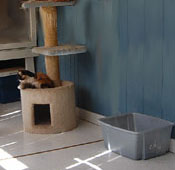 |
If you have ever been owned by a kitty, you will
understand the joy and companionship we are talking about here. During
their somewhat brief stay in this world, they become entwined in our
lives. We come to anticipate their wants and needs and they seem to
know the exact time we need comfort or a furry warm body close by.
Bringing a new cat or kitten into your home sounds
simple! However, if you want a successful transition, there are things
that you can do to ensure that all goes as well as possible.
Follow the breeder's directions and advice!! The
breeder will know the cat better than anyone.
Take time to read this entire page.
Learn proven methods on preparing for your new companion
|
|
You
must be patient acquiring an adult as they will be fearful at first
and understandbly so. They will not know who you are or where they are...so
you must have compassion and empathy for them. Once they adjust you
will have a loving little friend.
If you are willing to invest some
love and time, then an adult WILL come around - they are all different.
Some will adapt nearly instantly...and some may take 3 or 4 weeks...some
more. They are all individuals and the success is really dependent
upon the effort you are willing to put into it.
If you are looking for INSTANT gratification,
get a kitten or a puppy!!
Don't buy an adult because you can't
afford a kitten. I have seen this happen and seems like the buyer is
just never fully satisfied. If you are thinking, "I love my kitty
SO MUCH that I want two!" or "My kitty is lonely" Be
aware that sometimes, adding another cat can really upset things. And
many times, cats DO like being the only child!
OUR
cats are indoor only, not to be declawed nor ever dumped in a pound!
If
you cannot keep the cat, we will help you find a new home for it or
if possible, take it back. NOTIFY US FIRST!
|
|
Here are some essential
tidbits:
- Set up the initial Home
Base. Learn what it is and how to manage it BEFORE your cat comes
home
- "Mr Furry, please meet
Miss Snowball," or Proper Introduction to the
resident cat(s)
- Can't we all just get along!!!!
- Understanding fear and aggression
- "Miss Fluffy, let me introduce you to Mr
Fido!" Suggestions on cat-dog intros.
|
|
 HOME
BASE! --
This critical Step will be done BEFORE the new pet arrives. HOME
BASE! --
This critical Step will be done BEFORE the new pet arrives.
Q:
What is the worst thing you can do when you bring a new cat or kitten
home??
A : Opening
the carrier in the middle of the house and just letting the animal loose
What do you think will happen? CORRECT! The
cat will run and HIDE under the sofa, behind the dryer, under the bed...someplace
where you will have a hard time getting!!
This is NOT what you want for your cat's first experience...trauma.
This HOME BASE will become
their safe-haven. They will venture out as they feel safe to do so.
Some adjust faster than others...some in a few days, some in a few weeks,
but keep in mind, they are suddenly somewhere foreign and they don't
know what has happened nor do they know who you are.
I
can't tell you how many people actually do more harm than good by turning
a newcomer loose in the house right away!!! Doing this stands a good
chance of ruining the cat's ability to ever adjust properly.
|
 Make
a safe spot, or HOME BASE, for Your New Cat or Kitten Make
a safe spot, or HOME BASE, for Your New Cat or Kitten
before she arrives!!
|
 |
Remember,
coming into a new home will most likely be highly stressful for
YOU and your new kitten or cat.
Older cats may especially have a rough time in new and different
surroundings. |
|
What I mean is find a bedroom or somewhere
similar, and put all of the cat's things there, such as
the litter, the water, food, her scratch post....some toys.
Someplace where the kitty can claim as her own where no
other pet can invade and frighten. This gives her a chance
to quietly adapt to the new sites and smells and most importantly
- YOU.
I encourage you
to get a laser light as they ALL love to play chase and
it is a good ice-breaker.
She won't be confined
to here long..soon she will be curious and want to explore.
|
|
Set the carrier down, and let the cat rest
there for a few minutes...then, open the carrier and let her come
out on her own in the room that is desgnated as HOME BASE. No
doubt she will very carefully look around...take some sniffs,
and then probably go hide. This is normal. She may not eat or
drink or use the litter for a day or two. This is also normal.
Don't be worried.
Do
not let the kitty just stay HIDDEN!! Go GET her...pay
attention to her.
You need to be the proactive
one. I am always upset when I hear people say that the cat will
come to them when it is ready. Don't count
on it!! One that hides right away is desperately
afraid and needs consoling.
EXCEPTIONS:
Naturally there are exceptions to every rule.
A lot depends on the cat and the new environment. Let's say it's
just YOU and the new cat and you have an apartment. Then, you
likely do not need to start with a HOME BASE, but instead,
it is important to start the cat out near where her 'stuff' is.
Once you add other factors to the scene, such
as another pet, kids, a large house...you DO need the HOME BASE!!!
If the cat seems extremely agitated at not being near you (she
may have immediately attached herself to you as her safe-person)
then of course, do what makes her most comfortable. MUCH depends
on the personality of the cat.
|
 Spend
Time With Your New Cat in Her HOME BASE Spend
Time With Your New Cat in Her HOME BASE |
 |
If HOME BASE is not your bedroom, then make
certain you go and spend quality time with her several times a
day if possible
Keep kitty here for the first couple days.
After that, leave the door ajar..soon you will see her carefully
exploring or hear her at night! And, if she gets scared...she
knows she can dash back to HOME BASE! Make sure the door doesn't
get closed accidentally
|
|
Do not be above bribery! Buy a feather teaser
and a laser-light. Most cats can't resist these for very long.
Get some yummy treats. Again, don't give up.
|
 Be
Patient with Your New Cat Be
Patient with Your New Cat |
|
Remember: you are an emotional
human and this is a scared animal
In almost every case
where someone has adopted an adult from us, we hear the same types
of reactions. People think the cat hates them, and the person
feels angry or hurt. NOT TRUE!! This
is an animal not a person. So we need to set aside our human emotions,
and remember this is a frightened little animal who just wants
to feel safe.
So please do NOT be offended
or hurt if your efforts do not pay off in the first two weeks!
You probably think it's an exaggeration when we say
a MONTH is not too long!
|
|
|
The LONGER you let the cat
remain hiding, the harder it will be to win its trust.
Go and FETCH the kitty!
|
|
|
Get
down on their level so you are not such an imposing threat. |
 Understanding FEAR in cats:
Understanding FEAR in cats: |
|
|
People often mistake FEAR for aggressive behavior.
A fearful cat is usually one that is in hiding more often than
she is out in the open. A cat that is in hiding most of the time
can become ill.
Stress can:
- bring on cystitis (inflammation of the bladder)
which in turn can lead to inppropriate litter box habits
- cause cats that are anxious, stressed or
scared to calm themselves similar to the way nervous people
bite their nails.
|

|
|

|
Cats that exhibit fear actually can invite
aggressive behavior in other cats and fall victim to being ganged
up on. If a cat feels there is no way out, he may resort to aggression
as a tool. I call it the fish tank behavior because schools of
fish will literally pick at a targeted fish until they have killed
it.
If your cat has become the target of bullying,
you MUST take action. And remember, PUNISHMENT is NOT the solution!!
|
|
BRAIN FREEZE:
According to cat health sites, fear shuts down
the brain of the cat to the point where they no longer think or
reason and they simply go into attach-mode and the teeth and nails
all start showing.
Consequently you cannot
work with the cat at this point, nor should you ever attempt to
pick up a cat at this stage!!
Sometimes, all you can do is to toss blankets
over the warriors, and then, place them in separate areas before
uncovering.
|
|
|
 Multi-Cat
Household Multi-Cat
Household
Once your new kitty has adjusted to her HOME BASE
and you it is time to begin the introduction to the resident cat(s)
Again we HIGHLY suggest you consider getting a FELIWAY
plug in or the Good Behavior Calming Pheromone Cat Collars, available
at PETCO, or other pet supply places.
Keeping the cats separate will allow them to slowly
get used to each other's scents before their first face-to-face meeting.
Many times, one kitty will stick its paw under the door in an attempt
to meet the new kitty - you can other switch their blankets or beds
around to let them adjust to their different scents.
First Meeting!!
 |
Initially, you can place one kitty on a carrier
and let the other one sniff around. Then trade them off. Do this
for a few days.
If no one is hissing or growling, then time
to open the carrier door - do NOT force them together!!!!!
Watch your cats interact like this for about
a half an hour. Be prepared to intervene.
A little hissing or batting at each other is
normal behavior in a new multi-cat household. But if one or both
of your cats gives a very intense hiss or growl, or if they swat
at each other, close the door.
|
Never punish your cat for aggressive
behavior towards another cat. This will only make your cat more
stressed and upset and will prolong the aggression between the two cats.
Just close the door. Repeat this process until the visits become calmer.
One way to help break the ice and help your cats
to get used to each other in your multi-cat household is for you to
use an interactive cat toy and play with your cats together...a feather
teaser, a laser light...
You can also give healthy cat treats to each cat
on either side of the door.
Take
it slowly and let your cats set the pace.
 |
As a general rule, introducing two kittens
to each other is a piece of cake!
Not only ar ethey FUN to watch but within a
day or two, they have figured out who is boss and within two weeks,
they usually have become best pals.
Consider getting TWO if you are getting a kitten,
especially if you will be away a lot. Kittens need interaction.
|
|
|
 Can't
We all just GET ALONG?? Can't
We all just GET ALONG??
No! Not always!
 |
If
your cats are seriously fighting and are in danger of
hurting each other, use can try using a squirt bottle with water
and spray the cat who is acting overly aggressive. Or, put some
pennies ... or anything that makes noise...in a metal soda can.
Tape it shut of course. SHAKE this loudly to startle them, or toss
in their direction. Last recourse, you may need to toss a blanket
over them and scoop one cat up and tote it off |
****
Don't put yourself in the middle of a cat fight, as you could get seriously
hurt!!
KEEP THEIR NAILS CLIPPED!!! If you get bitten act
hastily to clean it. Remember an animal bite INJECTS bacteria directly
into your body. This is very dangerous and if any swelling starts, go
to the doctor ASAP!!! ****
|

What
the?? Hey!
This is MY basket!!
|
Some disagreements are bound to occur even
with the best of fur-friends.
There are simply lines that should not be crossed
such as occupying another purr-son's favorite bed, or stealing
some of their beloved toys...or perhaps even a sly look taken
the wrong way.
|

MINE!!!!
MY bed! MINE!!
|
|
|
Most cats will eventually learn
to co-habit. They may or may not be soul-mates. Some get along
fine - most of the time!
And in reality, some cats do
NOT want another cat around.
Unfortunately, you do not know
this until you have tried bringing in another one. And suddenly,
you notice that someone is no longer using the litter box or
their behavior has changed.
In sad cases like this, you
probably will have a hard time turning back the clock. Mostly,
you CAN make it work out...but it takes compassion and patience
and providing them their own 'space'
NOTE: many pet
places like PETCO carry "Good Behavior Calming Pheromone
Cat Collar" These definately HELP!!
|
|
Yes! We can!!
No two cats are alike. Today they
may enjoy a group activity like chasing Catnip bubbles. Or they
may enjoy some laser-light chasing time as a group. And yet, the
next day, someone might decide that someone else is 'is their
face' - and smack them and stomp off in a huff. As long as it
is not a vicious fight, not to worry
Typically groups of cats get along
reasonably well, although a normal household will likely NOT have
more than 5!!
|
|
 Introducing Miss Fluffy to Mr Fido
Introducing Miss Fluffy to Mr Fido |
 |
Since we don't have dogs here, our cats are
not used to being around them. However, a dog that is accustomed
to having a cat around ought to accept a new one. The new cat,
if not treated badly by the dog, in turn SHOULD adapt fine.
During the INITIAL meeting, always keep the
dog on a leash where you can if need be, separate them. Never
assume all will be well. They are animals remember. Keep any visits
supervised for the first several times. A cat that is over
4 months should be able to jump up onto a higher level
if necessary. Kittens younger than that should not be left alone
with the dog. They are simply too immature and fragile, ESPECIALLY
persians and himalayans.
Bear in mind that some breeds of dogs like
terriers were BRED to hunt down small creatures. Use common sense
and caution
|
Ahhh!! The well-adjusted cat!!

|




















